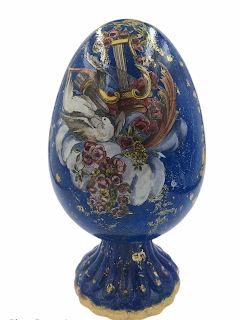Lapis Lazuli is one of the oldest of all gems, with a history stretching
back some 7000 years or more. This mineral is important not just as a
gem, but also as a pigment, for ultramarine is produced from crushed
lapis lazuli (this is why old paintings using ultramarine for their blue
pigments never fade).
With this photo tutorial I will show you how to create the effect of Lapis Lazuli on a large ceramic egg. Of course you can create this effect on any item of your choice.
Products needed:
1 ceramic egg with stand
Acrylic paints Burnt Sienna, Azul Ultramarine, Azul Marino, Light Blue, White
Gesso
Decoupage papers
Water based varnish
Glue
Mixion
Gold leaf
Gold powder
Step 1. Apply to the whole egg and the stand a coat of gesso and when dry paint the egg with two coats of Azul Marino.
Step 2. On your paint pallet pour out a little of all the shades of blue and using a synthetic sea sponge dab on the Azul Ultramarine and the light blue but do not cover the initial coat of paint completely.
Step 3. Using a brush dab on a little Burnt umber and then blend it using the sea sponge with a mixture of the blue paints.
Step 4. Using a fan brush add a little thick white paint to the tip and lightly dab on some white to create veins. Dab on some Burnt umber and some blue to create the veins.
Step 5. To create the gold veins apply mixion to various areas and then stick the gold leaf.
Step 8. Apply several coats of water based gloss varnish to complete your art work.























































